National Works
Pavilion of Kuwait
55th International Art Exhibition of the Venice Biennale
Curated by Ala Younis
1 June - 24 November 2013
Kuwait’s art scene is small, scattered, and clumsily endorsed by those who possess the unlimited resources and political sway to actually overhaul it. Many of its acting patrons are members of the ruling family who, as of late, have focused more energy on peacocking in regional art pageants than earnestly investing in the country’s cultural infrastructure. Taken as a whole, the Kuwaiti art scene currently lacks the institutional pull that it had in the 1970s and 80s when it was the first major art hub in the Gulf. On a micro level, however, there are efforts to upkeep the momentum that first put local art on the map, specifically among young practitioners who frequently shuttle in and out of the country and openly refuse to be burdened with the pretenses of Kuwait’s “polite society.”
Although in need of a sturdier foundation, the art scene is also driven by forward-thinking art spaces such as Sultan Gallery. Founded in 1969, Sultan’s story, however—which includes a fifteen-year hiatus after the Iraqi invasion—reflects the country’s uneven path over the past fifty years. An all-consuming inertia gripped Kuwait following the first Gulf War, as substantial nation-building efforts were abruptly suspended and its political climate worsened. A muffled aspect of this history is the mass expulsion of Palestinians and other non-Kuwaiti nationals who were targeted under an extensive state-led campaign of political persecution and scapegoating that involved aggressive roundups, torture, assaults, and assassinations. This chapter is vehemently avoided at all levels of local discourse. The present day existence of deteriorating pre-war relics—some of which were damaged during the conflict and left as eerie de facto shrines—points to a general unwillingness on the part of the Kuwaiti regime to rationally confront the events of this period, even if doing so might have long-term collective benefits or lead to necessary reconstruction. Although the Kuwaiti art scene has consequently suffered from a long list of stalled projects and the prolonged restoration of crucial, government-funded venues, there are indications that it could emerge as a critical location for overdue discussions.
National Works marks Kuwait’s first-ever participation in the International Art Exhibition of the Venice Biennale. Curated by Ala Younis and sponsored by the National Council for Culture, Arts, and Letters, the debut pavilion features sculptor Sami Mohammad and photographer Tarek Al-Ghoussein. While the pairing of such vastly different artists is surprising, Younis has taken a conceptual approach that is less concerned with traditional curating and more aligned with installation art. The outcome of this artistically inclined handling is a fascinating interplay between historical examples of Mohammad’s multifaceted oeuvre and a newly executed series of photographs by Al-Ghoussein. Revolving around the formation of national symbols during Kuwait’s modernization project of the second half of the twentieth century, the exhibition explores the emergence, dominance, and rapid decline of public monuments and sites that once represented the economic, political, and cultural aspirations of the Kuwaiti state, including the contemporaneous establishment of art initiatives.
At the entrance of National Works is a mid-size image from Al-Ghoussein’s K Files series, a large project that includes photographs and found materials relating to his personal history. In addition to executing a number of self-portraits in the shadows of some of the country’s most identifiable landmarks, Al-Ghoussein—who was born in Kuwait to Palestinian parents—is currently sourcing supplementary documents and objects through family records and collections, antique shops, and online marketplaces. In K Files_655 (2013), the artist can be spotted in the lower corner of the frame. Seated beneath a metal canopy in the courtyard of an office complex, his gaze is fixed on two larger-than-life bronze figures, the imperial visions of which nearly obscure his presence. These stately statutes were created by Mohammad decades before in honor of Abdullah Al-Salem Al-Sabah and his successor Sabah Al-Salem Al-Sabah—the eleventh and twelfth rulers of Kuwait, who are associated with the post-independence building period. Mohammad’s figures are the centerpieces of the pavilion yet primarily appear as the subject of documents or images. Two fragmented fiberglass copies, a bust of Sheikh Abdullah Al-Salem (1972) and the extended arm of Sheikh Sabah Al-Salem (1989), are on display and complemented by drawings, notes, brochures, clippings, and other miscellaneous records. While viewing the figures in their entirety would have certainly been impacting, these partial fragments remain wholly capable of communicating the authoritarian likeness that Mohammad so brilliantly, albeit unintentionally, cast in bronze. Abdullah Al-Salem’s portentous bust is placed just opposite of Sabah Al-Salem’s right arm, which is configured with its forearm and hand stretched out across the surface of a pedestal, causing the salutary gesture to disappear as the extracted detail takes on new meaning. In the exhibition’s catalogue, Younis describes a degree of political openness that characterized the start of Kuwait’s modernization project, as it sought to attract neighboring populations to its post-independence boom. In the intact examples that are shown in K Files_655, Mohammad’s commissioned sculptures pay homage to the concept of “public works for the people” through barely visible figures and texts that are located along the sides of his royal muses.
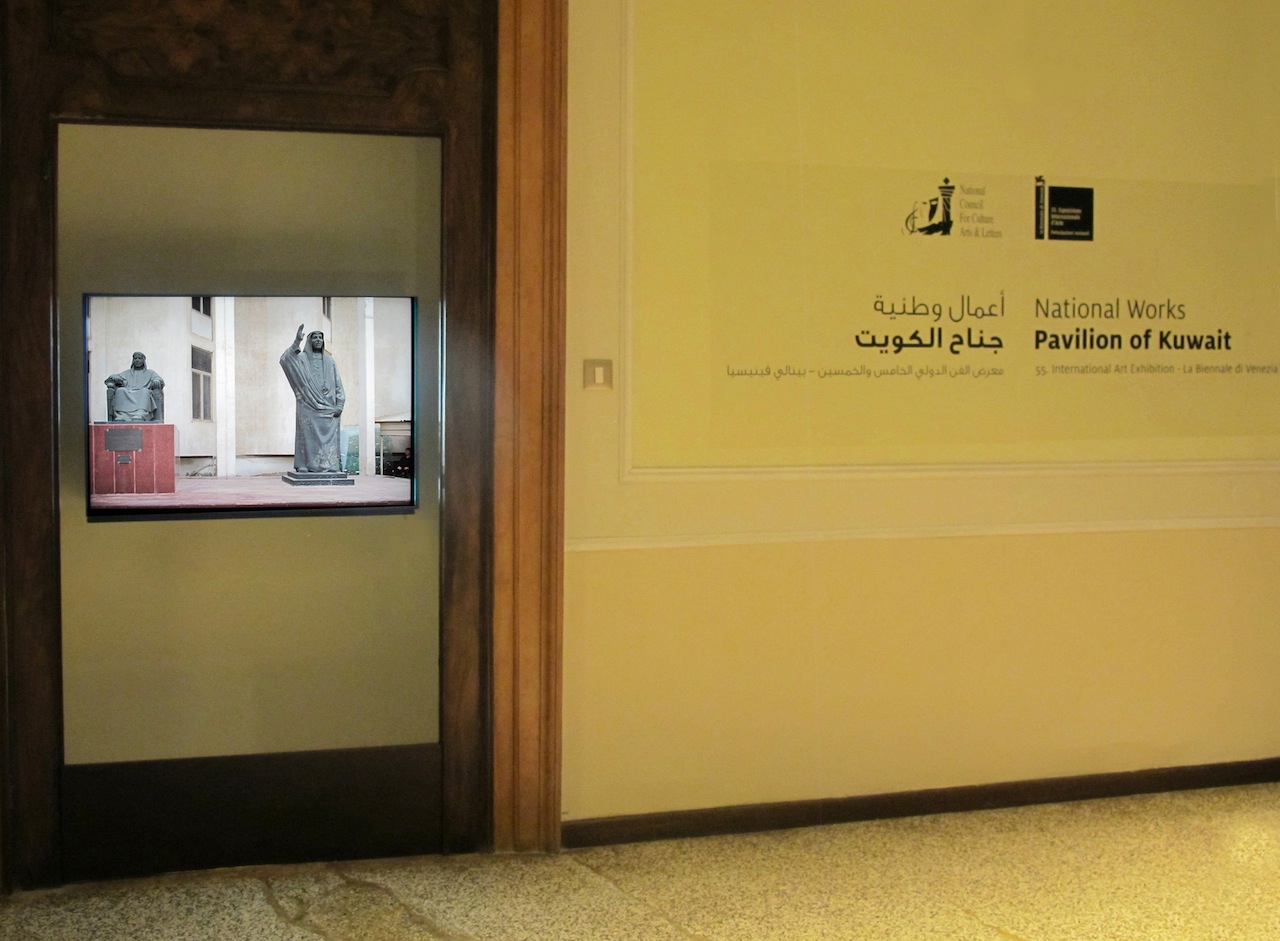 [Installation view of National Works. Image courtesy of the National Pavilion of Kuwait.]
[Installation view of National Works. Image courtesy of the National Pavilion of Kuwait.]
 [Installation view of National Works. Image courtesy of the National Pavilion of Kuwait.]
[Installation view of National Works. Image courtesy of the National Pavilion of Kuwait.]
To emphasize the scale of the statues for viewers, Younis has projected a snapshot of Mohammad in front of the original version of Sheikh Sabah Al-Salem in a foundry in London. The sculptor is shown crouching before the work as he attends to its lower portion. For the curator, this image encapsulates “an alternating power dynamic between an artwork and its maker, a state and its citizen, a ruler and his subject, a legacy and its inheritor, and a challenge and its acceptor.”
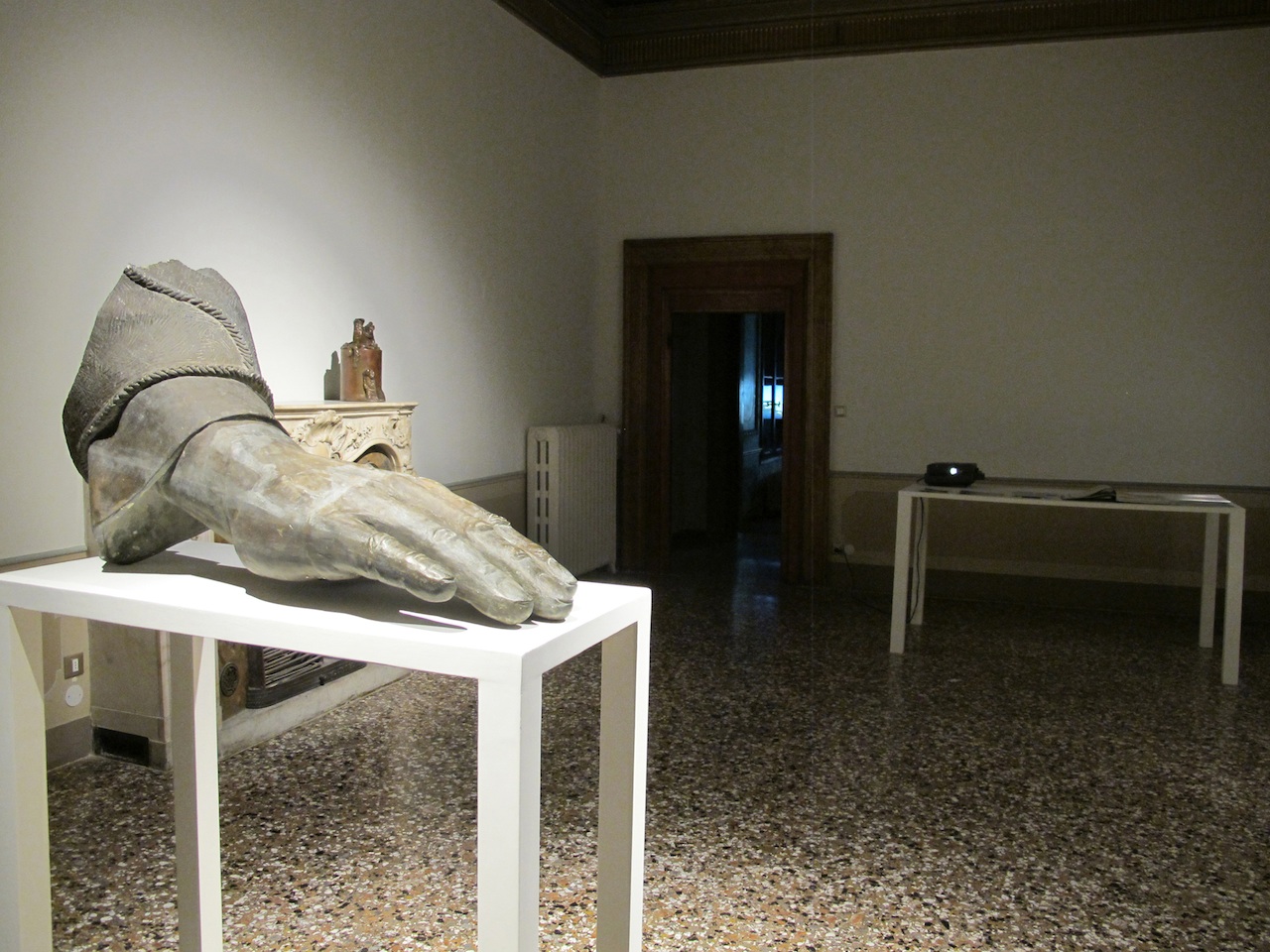 [Installation view of National Works. Image courtesy of the National Pavilion of Kuwait.]
[Installation view of National Works. Image courtesy of the National Pavilion of Kuwait.]
Departing from the galleries devoted to Mohammad’s statues, the remaining rooms of the pavilion contain freestanding illuminated panels displaying a selection of K Files photographs. Presented in pairs or singularly arranged, the captured sites include: Qasr Al-Salam, an abandoned palace that was left in further disarray by occupational forces; the Jørn Utzon-designed National Assembly, with its stark mid-century columns and sanitized marble floors; and Um Al-Gaz Island, behind which, across a section of the Persian Gulf meeting Kuwait City, stand the 1977 multipurpose towers that are the symbol of modern Kuwait. In each, the artist can only be found after one carefully surveys its hollowed location, where repeated architectural forms (windows, columns, rows of seating, etc.) make for monotonous scenery. The implied imbalance between the individual and these static embodiments of the state is articulated through the pared-down yet masterfully studied approach that Al-Ghoussein has built his career on.
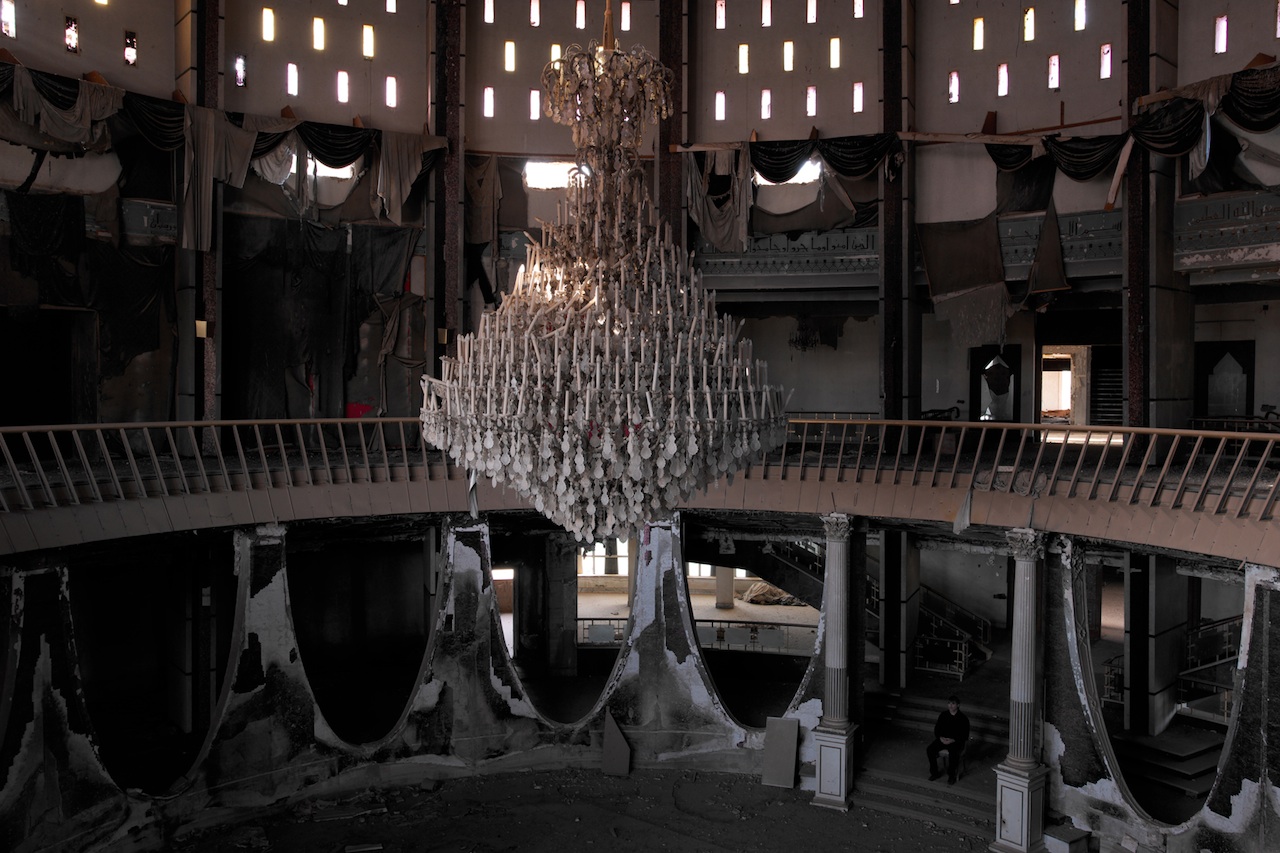 [Tarek Al-Ghoussein, "K Files 117" (2013). Image copyright the artist. Courtesy of the National Pavilion of Kuwait.]
[Tarek Al-Ghoussein, "K Files 117" (2013). Image copyright the artist. Courtesy of the National Pavilion of Kuwait.]
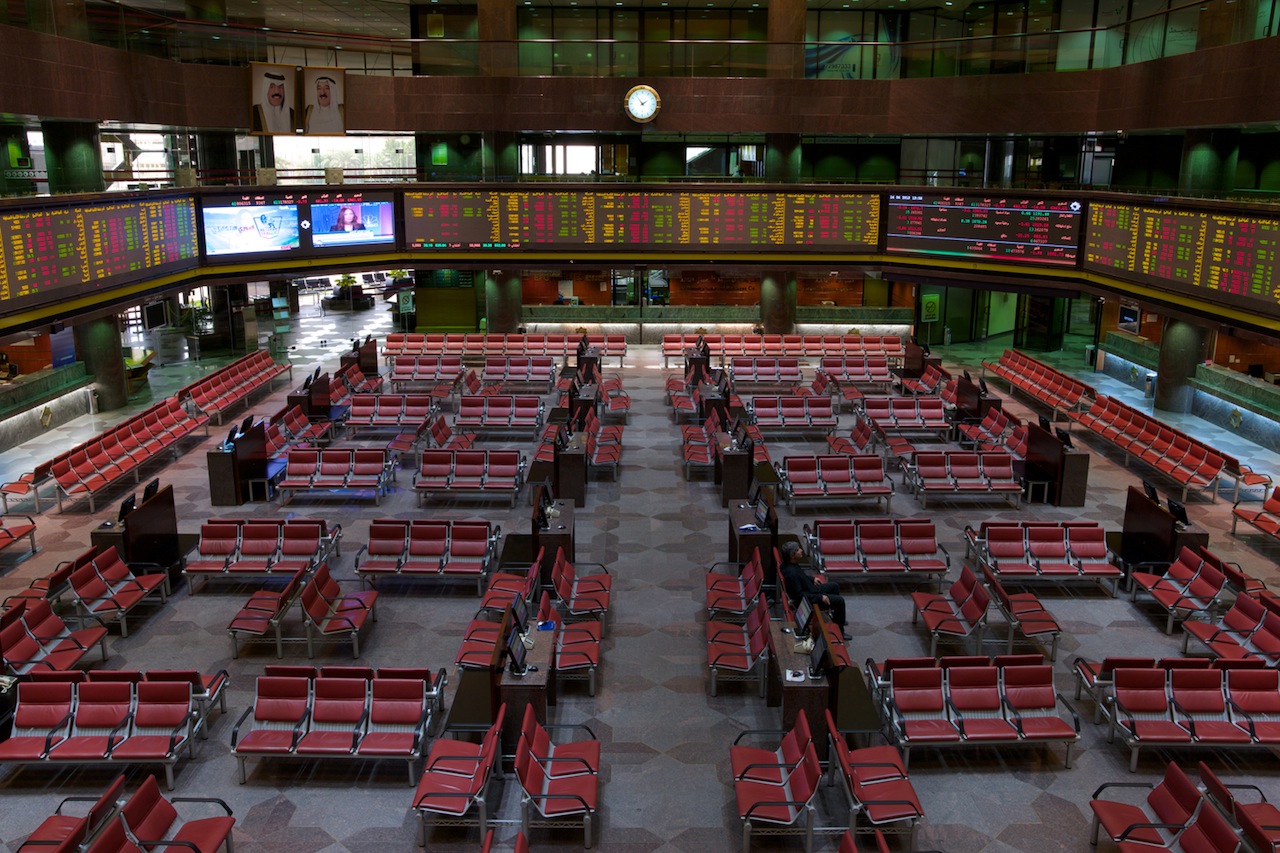 [Tarek Al-Ghoussein, "K Files 831" (2013). Image copyright the artist. Courtesy of the National Pavilion of Kuwait.]
[Tarek Al-Ghoussein, "K Files 831" (2013). Image copyright the artist. Courtesy of the National Pavilion of Kuwait.]
The artist’s light boxes are appropriately displayed in the most ornate rooms of the Palazzo Michiel Dal Brusà, an eighteenth-century Venetian palace that was once home to a family of magistrates. Younis has maximized the visual impact of the emptied quarters to enhance the desolate feel of the cavernous interiors and barren, manmade environs that overpower Al-Ghoussein’s portrait, revealing an urban terrain that is pockmarked with failed attempts of national majesty. The curator has placed each object and picture of National Works so that the past-glory patina of the palace is not mislaid as viewers engage with a more recent (foreign) tale of disintegrating grandeur, suggesting that a larger theoretical framework should be employed when considering the “performances of construction, creation, and political manifestation” of Kuwait’s former project. Given the politically informed posturing that takes over the Italian port city every two years under the guise of art and patronage, National Works seems to have been organized with a broad audience in mind.
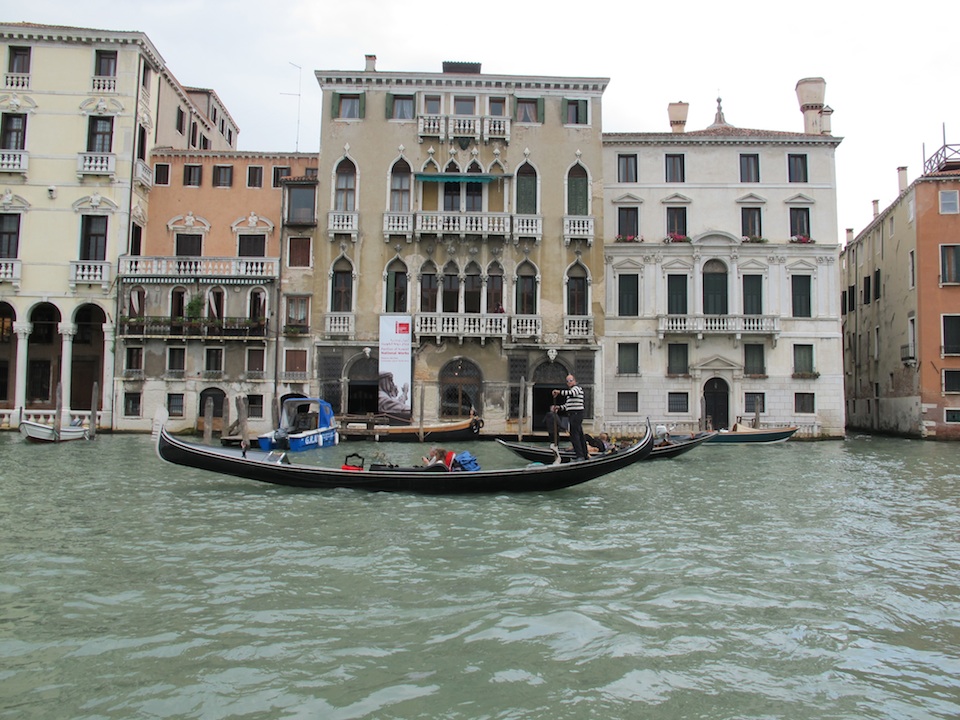 [The Palazzo Michiel Dal Brusà, 2013. Image courtesy of the National Pavilion of Kuwait.]
[The Palazzo Michiel Dal Brusà, 2013. Image courtesy of the National Pavilion of Kuwait.]
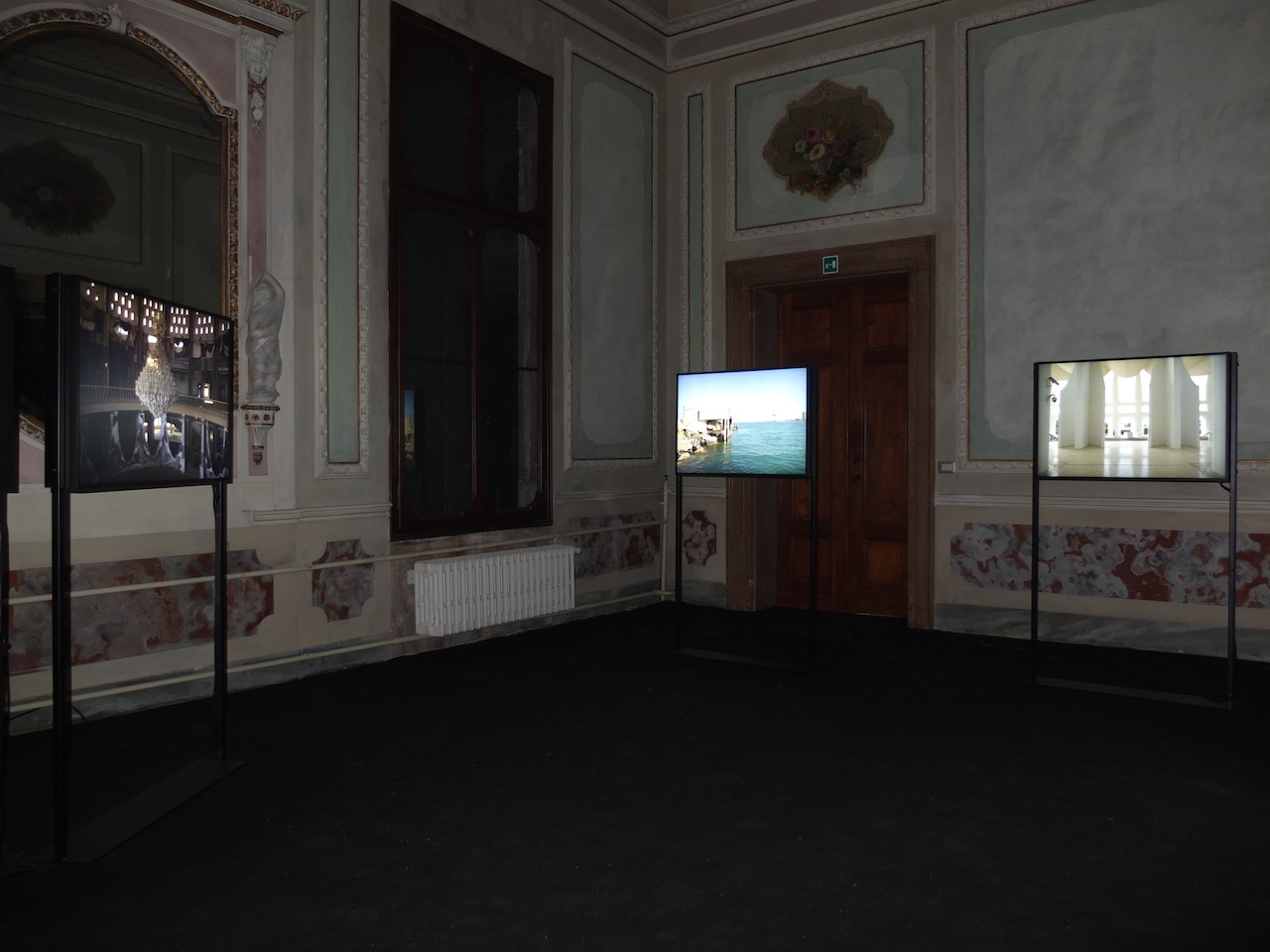 [Installation view of National Works. Image courtesy of the National Pavilion of Kuwait.]
[Installation view of National Works. Image courtesy of the National Pavilion of Kuwait.]
The pavilion’s accompanying publication is slim on in-depth analysis, perhaps because so much of the exhibition’s bite is left for the viewer to discover through a close reading of the installed work and its layout. The bulk of the catalogue is characterized by an uneven account of Kuwait’s modern history, with a few interesting anecdotes about the artists’ lives; for example, how Mohammed was sought after by Iraqi soldiers to create a public work in the likeness of Saddam Hussein during the occupation, or the little-known fact that Al-Ghoussein’s father was Kuwait’s ambassador to the United States in the early 1960s. (A picture of the artist as a young child shows him with his father in Washington DC beneath a state portrait of Abdullah Al-Salem). Other highlights include a brief overview of the art scene during its heyday with references to pioneering figures and the artist-run organizations and events that quickly gained regional standing and initially inspired officials to invest in the arts. Certainly curating a “national” exhibition is no easy task given the many political tightropes involved. As expected in this context, the tale of Kuwait’s cultural prosperity concludes in 1991 with a description of the Kuwait House for National Works, a private museum solely devoted to ensuring that “the crimes of the Saddam Hussein regime” during the invasion do not fade from public memory.
![[Tarek Al-Ghoussein, \"K Files 473\" (2013). Image copyright the artist. Courtesy of the National Pavilion of Kuwait.]](https://kms.jadaliyya.com/Images/357x383xo/TAGKFiles_473.jpg)










